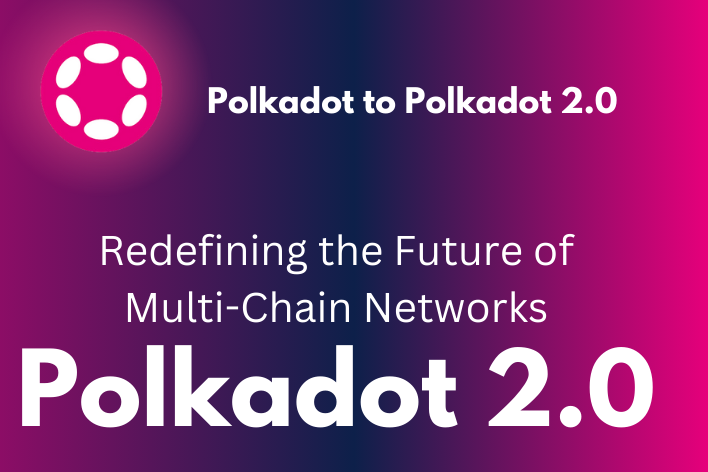Polkadot 2.0: Redefining the Future of Multi-Chain Networks
Polkadot 2.0: Redefining the Future of Multi-Chain Networks
Introduction:
Polkadot 2.0 marks a significant milestone in the evolution of blockchain technology, pushing the boundaries of what multi-chain networks can achieve. Originally designed to enable seamless interoperability among diverse blockchains, Polkadot has emerged as a leading platform for decentralized applications and cross-chain solutions. However, as the demand for faster, more scalable, and flexible blockchain ecosystems grew, so did the need for an upgraded framework.
Polkadot 2.0 introduces groundbreaking enhancements like asynchronous backing, elastic scaling, and the innovative Agile Coretime model, all aimed at addressing the limitations of its predecessor. These advancements not only boost the network's performance and accessibility but also pave the way for new possibilities in decentralized finance (DeFi), smart contracts, and beyond. As Polkadot continues to redefine the landscape of multi-chain networks, its 2.0 iteration positions it at the forefront of the next generation of blockchain technology.
From Polkadot to Polkadot 2.0
Polkadot was initially conceived as a groundbreaking platform designed to enable seamless interoperability among diverse blockchains. Leveraging its unique relay chain and parachain architecture, Polkadot allowed multiple blockchains to operate concurrently while maintaining robust security and scalability. This innovative approach quickly positioned Polkadot as a leader in the blockchain space, facilitating a wide array of decentralized applications (dApps) and projects that benefited from its multi-chain capabilities.
However, as the blockchain ecosystem grew and evolved, so did the demands placed on Polkadot. The increasing need for faster transaction speeds, greater flexibility in resource allocation, and enhanced scalability highlighted the limitations of the original design. Recognizing these challenges, the Polkadot team set out to develop Polkadot 2.0—a natural evolution of the network that addresses these limitations with advanced features and upgrades. Polkadot 2.0 not only enhances the network's performance but also introduces new possibilities for developers and users, ensuring that Polkadot remains at the forefront of the rapidly changing blockchain landscape.
Core Innovations in Polkadot 2.0
1. Asynchronous Backing: This is a pivotal upgrade that enhances transaction speed by enabling parachains to function independently. This innovation reduces processing times from 12 seconds to just 6 seconds and boosts data capacity fourfold. By decoupling the chains' operations, Asynchronous Backing allows for more efficient and scalable transactions, ultimately improving the overall performance and responsiveness of the blockchain network.
2. Agile Coretime: introduces a revamped auction model that lets users rent parachain slots for shorter periods, enhancing flexibility and cost-efficiency. This approach not only makes it easier for a broader range of projects to access parachain slots but also increases the liquidity of DOT tokens by encouraging more frequent and dynamic participation in the slot auctions. As a result, the blockchain ecosystem becomes more accessible and vibrant, fostering innovation and liquidity.
3. Elastic Scaling: It is a feature that dynamically allocates network resources based on demand, ensuring that parachains with higher workloads receive adequate support. By automatically adjusting resources, it enhances the overall scalability of the Polkadot network, allowing it to efficiently handle varying levels of activity and maintain optimal performance across all parachains. This flexibility supports robust growth and adaptability in the blockchain ecosystem.
4. Hermit Relay and JAM: Hermit Relay and JAM are innovations that decentralize the relay chain’s responsibilities, significantly boosting network efficiency. By distributing tasks across multiple nodes, these technologies enhance the overall performance and stability of the blockchain. Additionally, they pave the way for new development possibilities, including the integration of smart contracts, thereby expanding the range of applications and functionalities available within the network.
Impact on the Polkadot Ecosystem:
The recent upgrades, including Asynchronous Backing, Agile Coretime, Elastic Scaling, and the innovations of Hermit Relay and JAM, are set to significantly enhance Polkadot's position in the blockchain space. By improving scalability with faster transaction times and higher data capacities, and increasing accessibility through flexible parachain slot rentals, Polkadot is poised to support a wider range of applications and projects. Elastic Scaling ensures that resources are allocated efficiently, while Hermit Relay and JAM decentralize critical functions, making the network more robust and developer-friendly. These advancements not only solidify Polkadot's role as a leading multi-chain platform but also open the door to new possibilities in the cryptocurrency landscape, such as more complex smart contracts and innovative decentralized applications. Looking ahead, these upgrades may spur further technological developments and integrations, reinforcing Polkadot's influence and driving broader adoption across the blockchain ecosystem.
Conclusion:
Polkadot 2.0 stands at the forefront of innovation in multi-chain networks, marking a pivotal evolution in blockchain technology. With these advancements Polkadot 2.0 is set to revolutionize how multi-chain ecosystems operate. These enhancements not only promise increased scalability, flexibility, and efficiency but also pave the way for groundbreaking developments in decentralized applications and interoperability. As Polkadot 2.0 continues to shape the landscape of blockchain technology, it redefines the future of multi-chain networks, setting a new standard for innovation and adoption in the cryptocurrency space.
Explore the transformative power of Polkadot 2.0 and stay ahead in the blockchain revolution. Dive deeper into how these innovations can impact your projects and investments—join the conversation today and be part of the future of multi-chain networks!





